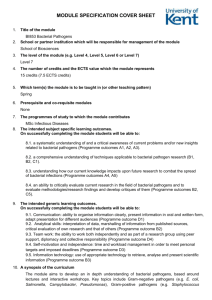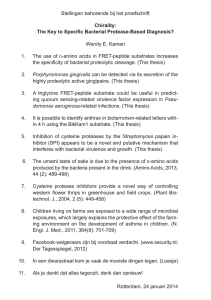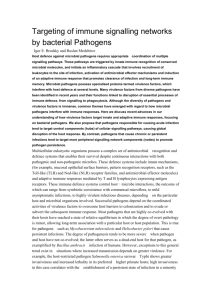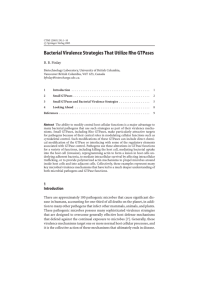Victor Nizet
advertisement
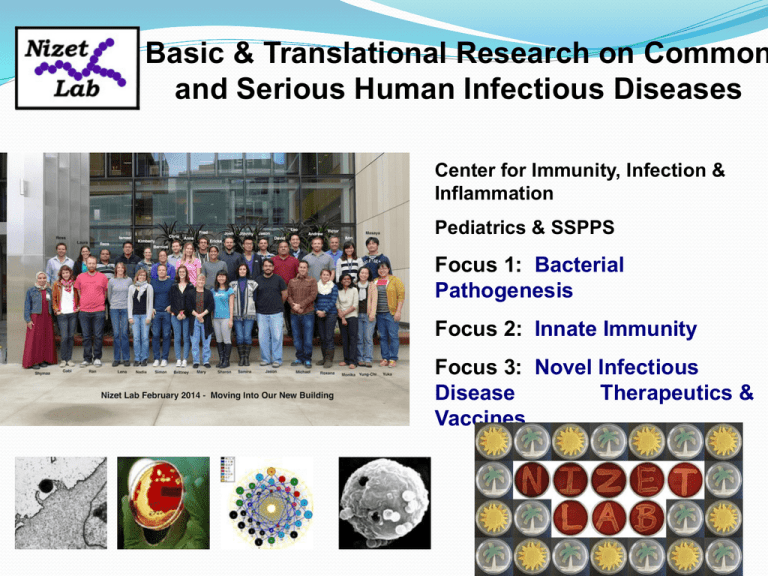
Basic & Translational Research on Common and Serious Human Infectious Diseases Center for Immunity, Infection & Inflammation Pediatrics & SSPPS Focus 1: Bacterial Pathogenesis Focus 2: Innate Immunity Focus 3: Novel Infectious Disease Therapeutics & Vaccines Research Interests Molecular pathogenesis of commong invasive bacterial pathogens: Virulence factor discovery, infectious disease modeling, understanding immune evasion GAS, GBS, MRSA, Pneumococcus, Anthrax, MDR Gram- Pathogens Understanding basic functions of the innate immune system: Antimicrobial peptides, complement system, macrophage and neutrophil function, receptor signaling, transcriptional regulation, autophagy, cell death, chemotaxis Glycobiology of the host-pathogen interface: Molecular mimicry by bacterial glycans (sialic acid, hyaluronic acid) Bacterial glycosidases in inflammatory activation Host glycan receptors (lectin) involved in pathogen recognition, immune regulation Glycoprotein remodeling in the immunopathogenesis of sepsis, coagulopathies Genetics and mechanism of action of bacterial toxins: Strep and staph pore-forming toxins/hemolysins, immune-disrupting proteases Anthrax toxins, cholera toxin, how they disrupt host barrier function Novel approaches to treat multi-drug resistant bacterial infections: Virulence factor inhibitors (disarm rather than kill the pathogen) Drugs that boost the killing activity of phagocytic cells (neutrophils/macrophages) Studying how antibiotics synergize with the innate immune system Passive and active vaccination strategies for challenging pathogens: Novel approach to safe and universal GAS vaccine Designer antibodies and drugs for passive immunotherapy of drug-resistant pathogens. Core Expertise Bacterial molecular genetics Mutagenesis, cloning, virulence factor discovery, “Molecular Koch’s postulates” Innate immune function analysis Antimicrobial peptides, complement system, macrophage and neutrophil function, receptor signaling, transcriptional regulation, autophagy, cell death, chemotaxis Tissue culture, flow cytometry, cytokines, Westerns, immunofluorescence, apoptosis, neutrophils extracellular traps (NETs), signaling, transcriptional analyses. Small animal models of bacterial infection: Past: Rats, rabbits, fish Current: Mice including multiple KO strains Sepsis, pneumonia, meningitis, skin infection, wound infection, UTI, foreign body Collaborative: Fruit flies, Worms Preclinical analysis of antibiotic activity: MIC/MBC testing (classical) and in the context of innate immune components Have hundreds of strains of all important contemporary MDR pathogens for testing. Spectrum and potency, post-antibiotic effect, risk of resistance, animal challenge for PK/PD Treatment in any of the animal models above Collaborations with Biotechnology/Pharma Companies Ongoing in the Laboratory New: high-throughput screening for compounds that sensitize MDR Grambacteria to clearance by the host innate immune system. (Liquid handling system being delivered this month for 384/96 well plate screens) Collaboration with Kary Mullis to redirect pre-existing antibodies we all possess to target MDR bacterial pathogens Repositioning prolyl-hydroxlase inhibitor drugs used in anemia/vascular disease therapeutics to boost white blood cell killing of MDR bacteria. Novel platform to recruit and activate neutrophils to the site of invasive fungal and bacterial pathogens. Fit-for-function biotherapeutics (single and multidomain antibodies) that optimally interface with the biology of each target antigen (MDR bacteria), to focus immune activation and mediate enhanced signaling Some of our collaborative research at scientific interfaces Richard Gallo Innate Immunity Michael Karin Cell Signaling Ajit Varki Glycobiolog y Edmund Capparelli PK/PD Jack Dixon Pharmacolog y Pieter Dorrestein Microbial Products Chris Glass Macrophage s Jeffrey Esko Glycobiology Partho Ghosh Structure/Functi on Ethan Bier Bacterial Toxins Emily Troemel Baxterial Toxins Brad Moore Marine Antibiotics
